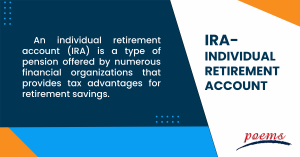Individual retirement account (IRA)
Table of Contents
Individual retirement account
Your retirement savings strategy may already be on the right track if you automatically contribute to a 401(k). However, you have additional options for retirement accounts.
A special technique to save for the future is through an individual retirement account (IRA). You have the option to use both a standard and a Roth IRA. Also, IRA alternatives are available if you work for yourself or own a small business.
What are individual retirement accounts?
In the United States, an individual retirement account (IRA) is a type of pension offered by numerous financial organizations that provides tax advantages for retirement savings.
It is a trust that oversees investment assets acquired with taxable revenue for the future retirement benefit of the taxpayer. An individual retirement account is a particular type of personal retirement plan, according to IRS Publication 590, Individual Retirement Arrangements (IRA).
Two more choices are employer-established benefit trusts and individual retirement annuities, in which a taxpayer purchases an annuity or an endowment contract from a life insurance company.

What are the types of individual retirement accounts?
The types of individual retirement accounts are:
- Conventional IRA
Many times, donations are tax deductible (commonly stated simply as “money is put before tax” or “contributions are made using pre-tax assets”). A traditional IRA can be either a “deductible IRA” or a “non-deductible IRA,” depending on the type of contribution.
- Roth IRA
Transactions within the IRA have no tax consequences, and contributions are not tax deductible. Earnings can be tax-free in retirement, and contributions can be withdrawn without penalties.
- SIMPLE IRA
A savings incentive match plan for Employee is one that compels employers to match employee contributions to the plan whenever an employee contributes. The plan is comparable to a 401(k), except that it has lower contribution caps and easier (and thus less expensive) administration. Despite being called an IRA, it is handled differently.
- Conduit IRA
A traditional IRA receives all its funding from eligible plans, including 401(k) plans.
- SEP IRA
It has a feature that enables an employer (often a small business or self-employed person) to make retirement plan payments into a Traditional IRA established in the employee’s name rather than to a pension fund in the company’s name.
Importance of individual retirement accounts
Individual retirement accounts are a significant asset since they are designed to give you money when you stop working. You won’t have any choice but to continue working past the “traditional” retirement age if you don’t have a retirement plan, as Social Security is unlikely to supply you with a sufficient income.
The amount an employee voluntarily contributes to his retirement account is only a portion of the asset’s overall value because most companies contribute to defined contribution plans. The most typical 401(k) match is 50 cents for every dollar deposited up to 6% of that employee’s gross compensation, although the calculations differ somewhat per business.
Additionally, retirement accounts allow you to postpone paying income tax on the money you contribute until you withdraw it, which results in significant tax savings. Therefore, during the years of contribution, the donated money is not considered part of taxable income.
Advantages of individual retirement accounts
The advantages of Individual Retirement Accounts are as follows:
- IRAs offer tax benefits
The most well-known benefit of IRAs may be their tax advantages, intended to motivate you to save money for the future. Traditional and Roth IRAs have slightly different tax benefits.
- IRAs are more adaptable and liquid than you would imagine
Roth IRAs offer a surprising degree of freedom. In contrast to a 401(k) or regular IRA, a Roth IRA allows you to withdraw contributions before age 59 without incurring additional taxes or penalties.
- IRA fees are frequently less than 401(k) plan fees
You normally pay advisory fees and what is known as the expense ratio when you invest. It’s critical to keep an eye on your expenses because they gradually reduce your earnings.
- Compared to 401(k) programs, IRAs offer greater investing alternatives
If you have a 401(k), you may have already realized that there aren’t many options available for investing your money. Fortunately, IRAs are an exception to this rule. IRAs offer a wide range of investment alternatives, like taxable investment accounts.
Disadvantages of individual retirement accounts
The disadvantages of Individual Retirement Accounts are as follows:
- Low yearly contribution limits apply to IRAs
The relatively low annual contribution caps are a disadvantage of using IRAs to save for retirement. A 401(k) plan allows for contributions of up to $20,500 in 2022, but an IRA only provides for donations of $6,000 (the maximum is $7,000 if you are at least 50 years old).
- Required minimum distributions apply to some IRAs
Once you turn 72 and have a traditional IRA, you must begin making required minimum distributions (RMDs), which are necessary yearly withdrawals of at least a certain amount. Your account balance at the end of the prior year divided by the “distribution period,” which is based on your age and determined by the IRS each year, yields the amount you must withdraw.
- Early withdrawal penalties can apply to IRAs at times.
If you have a traditional IRA and take out the money before you turn 59, you’ll typically be subject to income tax and a 10% penalty. This does not apply if you withdraw up to $10,000 for a qualified first-time home purchase or if you lose your job and withdraw to cover health insurance costs.
Frequently Asked Questions
An individual retirement account (IRA) is a tax-advantaged investment account created to encourage retirement savings. IRAs are one of the best methods to invest in and save for the future.
Although a wider range of investment options could be appealing, investors should know that self-directed IRA investments come with dangers, such as scams, exorbitant fees, and unpredictable performance. Investors can receive specific tax benefits for retirement savings through Individual Retirement Accounts (IRAs).
A tax-advantaged investing account called an IRA was established for people saving for retirement. Although there are fewer investing alternatives than with brokerage accounts, contributions and earnings grow tax-free or tax-deferred depending on whether you have a Roth or standard IRA.
Investors frequently use individual accounts for day trading, long-term investing, and saving for short-term financial goals like a home or car purchase. Investors can access tax-advantaged retirement funds through IRAs in the interim.
Traditional IRA funds, including earnings, are typically not taxed until given to you. IRAs cannot be jointly owned. However, your beneficiary or beneficiaries will receive any funds still in your IRA after your passing.
A Roth IRA is an individual retirement account into which you make after-tax contributions. The payments and earnings can grow tax-free, and you can withdraw them tax and penalty-free after age 59 and after the account has been open for five years, even though there are no current-year tax benefits.
Related Terms
- Mark-to-market
- Federal Open Market Committee
- FIRE
- Applicable federal rate
- Assets under management
- Automated teller machine
- Central limit theorem
- Balanced scorecard
- Analysis of variance
- Annual percentage rate
- Double Taxation Agreement
- Floating Rate Notes
- Average True Range (ATR)
- Constant maturity treasury
- Employee stock option
- Mark-to-market
- Federal Open Market Committee
- FIRE
- Applicable federal rate
- Assets under management
- Automated teller machine
- Central limit theorem
- Balanced scorecard
- Analysis of variance
- Annual percentage rate
- Double Taxation Agreement
- Floating Rate Notes
- Average True Range (ATR)
- Constant maturity treasury
- Employee stock option
- Hysteresis
- RevPAR
- REITS
- General and administrative expenses
- OPEX
- ARPU
- WACC
- DCF
- NPL
- Capital expenditure (Capex)
- Balance of trade (BOT)
- Retail price index (RPI)
- Unit investment trust (UIT)
- SPAC
- GAAP
- GDPR
- GATT
- Irrevocable Trust
- Line of credit
- Coefficient of Variation (CV)
- Creative Destruction (CD)
- Letter of credits (LC)
- Statement of additional information
- Year to date
- Certificate of deposit
- Price-to-earnings (P/E) ratio
- Quantitative easing
- Yield to maturity
- Rights of accumulation (ROA)
- Letter of Intent
- Return on Invested Capital (ROIC)
- Return on Equity (ROE)
- Return on Assets (ROA)
Most Popular Terms
Other Terms
- Physical ETF
- Initial Public Offering
- Buyback
- Secondary Sharing
- Bookrunner
- Notional amount
- Negative convexity
- Jumbo pools
- Inverse floater
- Forward Swap
- Underwriting risk
- Reinvestment risk
- Final Maturity Date
- Payment Date
- Secondary Market
- Margin Requirement
- Pledged Asset
- Yield Pickup
- Subordinated Debt
- Trailing Stops
- Treasury Stock Method
- Stochastic Oscillator
- Bullet Bonds
- Basket Trade
- Contrarian Strategy
- Exchange Control
- Notional Value
- Relevant Cost
- Dow Theory
- Speculation
- Stub
- Trading Volume
- Going Long
- Pink sheet stocks
- Rand cost averaging
- Sustainable investment
- Stop-limit sell order
- Economic Bubble
- Ask Price
- Constant prepayment rate
- Covenants
- Stock symbol
- Companion tranche
- Synthetic replication
- Bourse
- Beneficiary
- Witching Hour
- Widow and Orphan stock
- Public Float
- Closing Price
Know More about
Tools/Educational Resources
Markets Offered by POEMS
Read the Latest Market Journal

Back in Business: The Return of IPOs & Top Traded Counters in March 2024
Start trading on POEMS! Open a free account here! At a glance: Major indices continue...

Weekly Updates 15/4/24 – 19/4/24
This weekly update is designed to help you stay informed and relate economic and company...

From $50 to $100: Unveiling the Impact of Inflation
In recent years, inflation has become a hot topic, evoking strong emotions as the cost...

Japan’s Economic Resurgence: Unveiling the Tailwinds Behind Nikkei 225’s Record Leap
Source: eSignal, Intercontinental Exchange, Inc. In the heart of Japan’s economic landscape, the Nikkei 225...

Weekly Updates 8/4/24 – 12/4/24
This weekly update is designed to help you stay informed and relate economic and...

What Makes Forex Trading Attractive?
In a world where the click of a button can send goods across oceans and...

Weekly Updates 1/4/24 – 5/4/24
This weekly update is designed to help you stay informed and relate economic and company...

How to soar higher with Positive Carry!
As US Fed interest rates are predicted to rise 6 times this year, it’s best...












